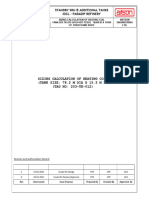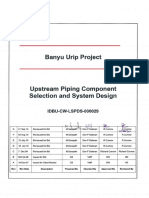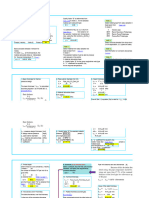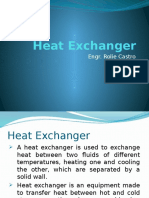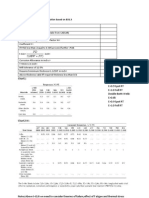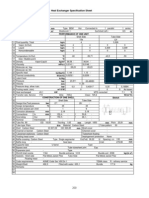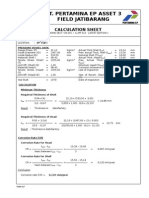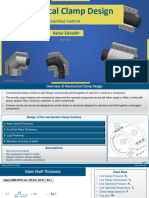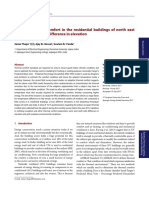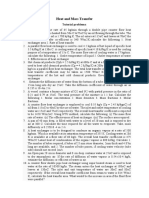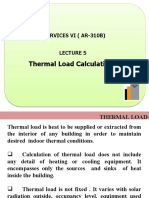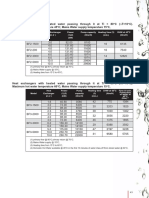14 Shell & Tube Exchanger
14 Shell & Tube Exchanger
Uploaded by
Edwin AldrinCopyright:
Available Formats
14 Shell & Tube Exchanger
14 Shell & Tube Exchanger
Uploaded by
Edwin AldrinOriginal Description:
Copyright
Available Formats
Share this document
Did you find this document useful?
Is this content inappropriate?
Copyright:
Available Formats
14 Shell & Tube Exchanger
14 Shell & Tube Exchanger
Uploaded by
Edwin AldrinCopyright:
Available Formats
Last Rev.
: 11 JUN 08
SHELL & TUBE HEAT EXCHANGER : MIME 3470
Page 1
Grading Sheet
~~~~~~~~~~~~~~
MIME 3470Thermal Science Laboratory
~~~~~~~~~~~~~~
Laboratory 14
~~~~~~~~~~~~~~
SHELL-AND-TUBE HEAT EXCHANGER
~~~~~~~~~~~~~~
Students Names / Section
POINTS
APPEARANCE, ORGANIZATION, ENGLISH/GRAMMAR
ORDERED DATA, CALCULATIONS & RESULTS
ORDERED DATA
CALCULATE HOT & COLD AVERAGED MEAN TEMPS, Tm
INTERPOLATED PHYSICAL DATA AT APPROPRIATE TEMPS
CALCULATE HOT AND COLD FLOW RATES, Cmax, Cmin, and Cr
CALCULATE TUBE-SIDE HEAT TRANSFER COEFFICIENT
CALCULATE AVERAGE FLOW AREA ON SHELL SIDE
CALCULATE SHELL-SIDE HEAT TRANSFER COEFFICIENT
INTERPOLATE C1 & m BOTH VERTICALLY & HORIZONTALLY
CALCULATE OVERALL HEAT TRANSFER COEFFICIENT
CALCULATE NTU
CALCULATE EFFECTIVENESS
CALCULATE OUTLET HOT WATER TEMPERATURE
CALCULATE OUTLET COLD WATER TEMPERATURE
CALCULATE PERCENTS ERROR
SUMMARY TABLE OF RESULTS
5
5
5
5
5
5
5
5
5
5
5
5
5
5
5
DISCUSSION OF RESULTS
5
5
5
5
HOW GOOD IS THE NTU METHOD?
EXPLAIN SOURCES OF ERROR
CONCLUSIONS
ORIGINAL DATASHEET
TOTAL
COMMENTS
GRADER
100
SCORE
TOTAL
Last Rev.: 11 JUN 08
SHELL & TUBE HEAT EXCHANGER : MIME 3470
MIME 3470Thermal Science Laboratory
~~~~~~~~~~~~~~
Laboratory . 14
SHELL-AND-TUBE HEAT EXCHANGER
~~~~~~~~~~~~~~
LAB PARTNERS: NAME
NAME
NAME
SECTION
EXPERIMENT TIME/DATE:
NAME
NAME
NAME
TIME, DATE
IMPORTANTWhen using the Heat Exchanger Performance
Test Bench, there are some important items to remember
for your safety and the safety of others.
they make many passes. This experiment employs a shell-and-tube
heat exchanger consisting of two tube passes and one shell pass.
THEORY: HEAT EXCHANGER ANALYSIS
Thermodynamics and the First Law dictate the overall energy
transfer in a heat exchanger. There are two widely used methods
of heat exchanger analysis, the NTU-Effectiveness method and the
Log-Mean-Temperature-Difference (LMTD) method. These are
briefly discussed below.
Log-Mean-Temperature-Difference (LMTD) Method
For a heat exchanger between two fluids with given inlet and outlet
temperatures, there are three equations for the rate of heat transfer, Q,
Q = Rate of heat transfer, W
c T1,i T1,o
= m
1 p
1.
Make sure the proper inlet and outlet valves are
open before the heat exchanger is operated. Failure to do
this will pressurize the system and rupture the heat
exchanger seams. As a rule of thumb, do not close any of
the outlet ball valves more than half way. In particular,
make sure the outlet valves that allow the water to go to
the drain are open prior to turning on water.
2.
For meaningful data, bleed taps will need to
be opened and closed to allow air to escape while the
experiment is going on. Outlet valves may be closed
SLIGHTLY to help keep the heat exchanger full.
OBJECTIVE of this experiment is to measure the two inlet temperatures and the mass flows through the shell and tubes, in order to predict
the two outlet temperatures using the NTU method and compare these
predicted values with actual measured outlet temperatures.
INTRODUCTIONMany engineering applications involve a
process of heat exchange between two fluids. Heat exchangers are
devices used to promote the heat transferred between two fluids; e.g.,
a car radiator and the condenser units on air conditioning systems.
Space heating, air conditioning, power production, and chemical
processing are typical areas of application.
There are many heat exchanger designs. The laboratory setup for
this experiment contains three heat exchanger types: a shell-and-tube
exchanger, a concentric tube exchanger, and a tube bank exchanger
in cross flow. This particular experiment employs the shell-and-tube
type heat exchanger (see Figure 1). A shell-and-tube heat exchanger
is constructed of tubes that are attached on each end by a plate, called
the tube sheet, through which the tubes pass. One fluid streams into
the inlet of the heat exchanger, flows through the tubes, and exits
through the tube sheet at the opposite end of the heat exchanger.
Page 2
c T2,i T2,o
m
2 p2
1
UA
T1,i T2,o T1,o T2,i
T1,i T2,o
ln
T1,o T2,i
Tlm
where, m
j = mass flow rate of fluid j, kg/s
cp
= specific heat of fluid j, J/(kgK)
T = temperature, C
i inlet
o outlet
U = overall heat transfer coefficient, W/(m2K)
A = area of surface across heat transfer occurs, m2
For known specific heats, U, A, and entering temperatures, the
three equations above can be solved for three unknownsT1,o, T2,o,
and Q by successive substitution of one of the equations for Q onto
another. It is a simple matter to use the log-mean-temperaturedifference method of heat exchanger analysis when the fluid inlet
temperatures are known and the outlet temperatures are specified or
readily determined from the energy balance expressions. The value
of Tlm for the exchanger may then be determined. However, if only
the inlet temperatures are known, use of the LMTD method requires
an iterative procedure. In such cases, it is preferable to use an
alternative approach, termed the NTU-Effectiveness method.
NTU-EFFECTIVENESS METHODOften, when working with a given
heat exchanger one must predict the outlet temperatures given the
inlet temperatures. As the dimensions of the exchanger are known, the
NTU-effectiveness method is a popular way to perform this task. This
is an easy method to calculate the overall heat transfer rate, Q. The
number of (heat) transfer units, NTU, is a dimensionless parameter
which precipitates form the heat exchanger analysis and is defined as:
Figure 1Schematic of shell-and-tube exchanger
A shell encloses the internal volume where the tubes are housed.
Another, fluid flows through the shell and heat is exchanged between
the tube-side fluid and the shell-side fluid. In a power plant, most heat
exchangers are of the shell-and-tube design. The number of passes
commonly presents a further description of a shell-and-tube heat
exchanger. A single pass means the fluid flows straight through the
entire heat exchanger without changing direction and so, in this
design, the fluid moves past the length of the heat exchanger only a
single time. In a two-pass heat exchanger the fluid in the tubes goes in
one end, flows to the other end, reverses direction then flows back to
the same end that the fluid entered through a second set of tubes.
Thus, the fluid travels the full length of the heat exchanger twice.
Similarly, multiple pass heat exchangers are so named because
NTU
where
UA
,
C min
U Overall heat transfer coefficient (W/m2K)
A Area of heat transfer (m2)
C cp
CC = m
(1)
(2a)
Cold fluid heat capacity rate
H cp
CH = m
H
Hot fluid heat capacity rate
Cmin = min(CC, CH)
Smaller of the two heat capacity rates (W/K)
(2b)
Last Rev.: 11 JUN 08
SHELL & TUBE HEAT EXCHANGER : MIME 3470
Cmax = max(CC, CH)
Larger of the two heat capacity rates (W/K)
Note that NTU is a function of geometric and material properties,
and the mass flow rates. It does not include any fluid temperatures.
Using the calculated NTU, the effectiveness of the heat exchanger, ,
can be calculated from tables where the effectiveness formulae for
different heat exchanger arrangements can be found. In such tables,
another dimensionless term that precipitates from the analyses
appears. This is the heat capacity rate ratio, Cr = Cmin/Cmax. For a
shell-and-tube exchanger with one shell pass and some multiple of
two tube passes, the effectiveness is
1/ 2 1 e
2 1 C r 1 C r2
1 e NTU 1 C
NTU 1 C r2
1/ 2
2 1/ 2
r
Page 3
ture are noted. This is the steady-state conditionuse only the
associated flow rates and temperatures for calculations.
DETAILED COMPUTATIONAL PROCEDURE
The NTU method will be described using just one tube; but that
single tube could represent an entire tube bundle. The NTU method
calculation procedure for a shell-and-tube heat exchanger follows:
H and m
C (from
1. a. Determine cold and hot water flow rates, m
rotameter readings), and their specific heats, c p H and c p C
(look up values based on the average of the inlet and outlet
, are kg/s and those
tempe-ratures). The units of mass flow, m
of specific heat, cp, are J/(kgK). [NOTE: Some tables list
specific heat as kJ/(kgK)so always check units!!]
Hot water inlet thermometer
Qactual
Actual rate of heat transfer
Qmax Maximum possible rate of heat transfer that an
exchanger of infinite heat transfer area
would have if it had the same inlet temps, flow
rates, & specific heats as actual case
Cold water
inlet
thermometer
Cold water
outlet
thermometer
Heat Exchanger Effectivenessis defined as
Distance between Tube Sheets, 16-1/8
(inside face to inside face)
5 Baffles, 1.2 thick. Equally spaced to form 6
chamber. 23 tube penetrations per baffle.
30 Tubes, each 0.25 diameter
neglect wall thickness
Hot water
outlet
thermometer
Shell: 5 OD
4.5 ID
The maximum heat transfer occurs in the fluid with the least
capacity to absorb or give off heat. This is the fluid with the
The width of the
flow course
varies & thus
the average
velocity
C p = Cmin. If this fluid is the cold fluid,
minimum value of m
its temperature cannot rise above the hot-side, inlet temperature.
Alternately, if the fluid is the hot fluid, it cannot be cooled below
the cold-side, inlet temperature. Thus,
Q
actual
Qmax
m c p
Qactual
Thot ,in Tcold ,in
min
S = 0.475
As the actual heat transfer is the same for both fluidsone
gaining thermal energy and the other loosing an equal amount
the actual heat transfer rate is defined by both
cp
Qactual m
TC ,o TC ,i
and
c p TH ,i TH ,o .
Qactual m
H
These last two relations yield the outlet temperatures desired.
LABORATORY PROCEDURE
1. Verify the dimensions and features of Figure 2.
2. Generally, small flow rates will generate better results but may
take longer to reach steady state. Also, do not let the air that comes
out of entrainment accumulate in shell. Use bleed taps as needed.
3. For a hot water flow of about 15% of the maximum rotameter
reading and a cold water flow of about 30%, take inlet and outlet
temperatures of both flows until no further changes in tempera-
S = 0.548
T
S = 0.548
D
Figure 2 Experimental apparatus with dimensional data
b. Calculate a temperature specific energy flow known as the
heat capacity rate, C, for both the cold and hot flows
Ccold m cold c pcold The larger of these is Cmax
Chot m hot c phot and the smaller Cmin
c. Calculate the heat capacity rate ratio, Cr = Cmin/Cmax.
Last Rev.: 11 JUN 08
SHELL & TUBE HEAT EXCHANGER : MIME 3470
2. Calculate the heat transfer coefficients at the inside and outside
surfaces of the tubes, hinside and houtside. These are used to compute
the overall heat transfer coefficient, U. (See Figure 3)
houtside
hinside
Page 4
ST/D
1.25
SL/D
0.600
0.900
1.000
1.125
1.250
1.500
2.000
3.000
C1
0.518
0.451
0.404
0.310
1.5
0.556
0.568
0.572
0.592
C1
0.497
0.505
0.460
0.416
0.356
2.0
m
0.558
0.554
0.562
0.568
0.580
C1
0.446
0.478
0.519
0.452
0.482
0.440
3.0
m
0.571
0.565
0.556
0.568
0.556
0.562
C1
0.213
0.401
0.518
0.522
0.488
0.449
0.428
m
0.636
0.518
0.560
0.562
0.568
0.570
0.574
Table 1Constants of for airflow over a staggered tube bank
Figure 3Heat transfer coefficients at inside and outside tube surfaces
a. Flow Inside Tubes: Even though there are many tubes in the
bundle and there are parallel and counter flows in this two-pass
exchanger, the calculation may be performed by considering the
flow in just one of the tubes WITH THE CAVEAT THAT one must
account for the direction of the flow. That is, half of the tubes are
associated with parallel flow and half the tubes are associated
with counterflow. Thus, the mass flow in the equivalent tubes is
total tube - side
m
flow
ST
Vavg, T
A2
A1
N 2
inside 1 tube
m
where, N = total number of tubes.
From simple flow relations, it is known that the velocity
inside a single tube is
Vinside
inside
m
A
Nu D 3.66
where fluid properties are based on the mean (or bulk)
temperature across a cross section, Tm.
If the flow is fully developed, turbulent (Re 10,000),
n 0.4, Ts Tm
n 0.3, Ts Tm
Figure 4Staggered tube arrangement
Re D ,max Vmax D / is defined for the maximum
where, A = cross sectional area of one tube.
Given
this
velocity,
a
Reynolds
number
(
Re Vinside D ) can be computed to indicate whether
the inside flow is laminar or turbulent. This will most likely
be fully-developed, laminar flow. For such with constant
surface temperature, Ts, and Pr ~
0.6 :
NuD 0.023Re4D/ 5 Pr n
SD
SL
Tube-side fluid properties should be evaluated at the
average of the mean temperatures, Tm
Tm,i Tm,o
2
velocity occurring within the tube bank, Vmax, which occurs
at one of two locationseither in way of A1 or A2 (see
Figure 4). The maximum velocity will occur at A2 if
2 S D D S T D . The factor of 2 results from the
bifurcation experienced by the fluid moving form the A1 to
the
A2
planes.
In
this
case,
Vmax S T 2 S D D Vavg , otherwise it occurs at
ST
A1 and Vmax S T
Note: The average velocity of flow over the tube is not
constant as the shell is not wall-sided but circular. Thus,
one needs to use some average value of area. To use the
relations for staggered tube arrangements, a free-stream, shellside, fluid velocity must be determined. As the sides of the shell
are circular, this free-stream velocity varies. Thus, an average
free-stream velocity must be determined based on an average
width of the shell, wavg. This can be obtained from simple
integration as
r
r 1
r2 x2 2 dx
wavg
b. Shell Flow Outside of Tubes: For the staggered tube
arrangement of the experiment shown in Figure 4, use the
following expression for the average Nusselt number
1/ 3
Nu D 1.13C1 Re m
.
D ,max Pr
(3)
Use Table 1 to determine m and C1. Note in the report which
values of m and C1 were used. This relation applies when there
are more than 10 tubes in a bundle (NL 10), 2000 < ReD,max <
40,000 where ReD,max is defined below, and Pr 0.7. average
mean temperature of the fluid, Tm , as defined above.
D Vavg .
1dx
At this point, wavg is determined and an answer could be listed aswavg 1.571
Allternately, the expression above could be selected and then
choose SY MBOLICS: EVALUATE : SYMBOLICALLY
from the menu to yield
wavg
r
2
Multiplying this with the distance between baffles gives an
average cross-sectional area, Aavg, for the flow and the
average velocity, Vavg, can be determined from V =
AavgVavg.
3. a. Calculate the overall heat transfer coefficient, U
Last Rev.: 11 JUN 08
SHELL & TUBE HEAT EXCHANGER : MIME 3470
1
hinner
k tubes
houter
0
Assume tubes
are thin - walled
& very conductive
where, t = the tubing thickness
Then NTU is
This value
UAtube surface
NTU
should be
Cmin
dimensionless
Now, the heat exchanger effectiveness, , can be determined.
For one shell pass and two tube passes the effectiveness is
2 1 C r
1/ 2
1 C r2
1 e NTU 1 C
2 1/ 2
1 e NTU 1 C r
2 1/ 2
r
PHYSICAL PROPERTIESAs the liquid (water) is moving, it
must be under a slight pressure. This experiment is interested in the
properties of liquid water density and specific heat which are both
functions of temperature and pressure. However, at low pressures,
one may assume that density and internal energy are approximately
equal to their saturated liquid values at the same temperature; i.e.,
(T, p) f(T) and u(T, p) uf(T). Thus, density can be defined.
Enthalpy is, h(T, p) hf(T) + [p psat(T)]/f(T). At a room temperature
of, say, 70F (~21C), psat = 0.02487bar. Compared to atmospheric
pressure of 1.01325bar, this is small and negligible. Thus,
h(T, p) hf(T) + p/f(T). At the temperature assumed, the density of
water is 998kg/m3. At small pressures, say 2atm = 2.02bar,
p/f(T) = 0.202 kJ/kg while hf(T) = 88.14 kJ/kg. Thus, a fair approximation of enthalpy is h(T, p) hf(T). Finally, the definition of specific
heat is h = c(T) T; thus, C (T, p) C f(T).
Page 5
Last Rev.: 11 JUN 08
SHELL & TUBE HEAT EXCHANGER : MIME 3470
FOR THE REPORT
1. Be sure to clearly state/show the calculations along with any
assumptions made on the Mathcad worksheet in the order
appearing on the grading sheet. Of course, you may have other
intermediate calculations.
Page 6
2. Indicate sources of error in equations as they apply to the shelland-tube heat exchanger in the lab, as well as sources of error in
the measurements.
3. Discuss how good is the NTU method.
Last Rev.: 11 JUN 08
SHELL & TUBE HEAT EXCHANGER : MIME 3470
Page 7
ORDERED DATA, CALCULATIONS, and RESULTS The object below is reduced to 70% of full size.
MAT HCAD OBJECT--DOUBLE CLICK TO OPEN
DATA
Look Up (& Interpolate) Physical Properties For The 2 Mean Temperatures C alculated At The Right
1a. Determine Flow Rates Of Hot And Cold Fluids
1b. C alculate Heat Capacity Rates, The MAX & MIN Heat Capacity Rates,
& The Heat Capacity Rate Ratio
2a. Calculate Heat Transfer Coefficient For Tube Side
2b. C alculate Heat Transfer Coefficient For Shell Side
3a. Calculate Heat Exchanger Effectiveness
3b. C alculate Outlet Temperatures
The Measured Outlet Temperatures Were
Last Rev.: 11 JUN 08
SHELL & TUBE HEAT EXCHANGER : MIME 3470
DISCUSSION OF RESULTS
Discuss how good is the NTU method.
Indicate sources of error in equations as they apply to the shelland-tube heat exchanger in the lab, as well as sources of error in
the measurements
CONCLUSIONS
Page 8
Last Rev.: 11 JUN 08
SHELL & TUBE HEAT EXCHANGER : MIME 3470
Page 9
APPENDICES
APPENDIX ADATA SHEET FOR SHELL-AND-TUBE HEAT EXCHANGER LAB
Time/Date:
___________________________
Lab Partners:
___________________________
___________________________
___________________________
___________________________
Verify supplied dimensions given in Figure 2. Is anything else needed?
Is the hot flow on the tube side or shell side? ______________
Rotameter max flow rate: ________________
Run
Cold
Volumetric
Flow Rate,
V
Hot
Volumetric
Flow Rate,
V
Hot Outlet
Temperature,
T H ,o
Hot Inlet
Temperature,
T H ,i
Cold Outlet
Temperature,
TC ,o
Cold Inlet
Temperature,
TC ,i
( % of max
( % of max
(C)
(C)
(C)
(C)
rotameter rating)
rotameter rating)
1
2
3
4
5
APPENDIX BPHYSICAL PROPERTIES TABLE
You might also like
- Ael-2597-Mec-Cl-0305-R1 - Sizing Calculation of Heating CoilDocument3 pagesAel-2597-Mec-Cl-0305-R1 - Sizing Calculation of Heating Coilpavan0% (1)
- Excel-Template Natural-Convection Sphere Si UnitsDocument2 pagesExcel-Template Natural-Convection Sphere Si UnitsKatie BensonNo ratings yet
- Shell and Tube Heat ExchangerDocument36 pagesShell and Tube Heat ExchangerSiti Nurshahira67% (3)
- Atmosphere Basics WebsquestDocument2 pagesAtmosphere Basics Websquestapi-264228415100% (1)
- IDBU-CW-LSPDS-000029 Rev G - Upstream Piping Comp. SelectDocument115 pagesIDBU-CW-LSPDS-000029 Rev G - Upstream Piping Comp. Selectjoey garciaNo ratings yet
- Double - Pipe - Exchanger (Para o Lado Ar)Document4 pagesDouble - Pipe - Exchanger (Para o Lado Ar)gabrieltravassosNo ratings yet
- ATV Primary Heat ExchangerDocument41 pagesATV Primary Heat Exchangeroverlord5555No ratings yet
- Sudyrah, Station Design Calculation of Existing Steel Tank Inlet Connection N-1 Doc. No.96-QC20-J-414Document7 pagesSudyrah, Station Design Calculation of Existing Steel Tank Inlet Connection N-1 Doc. No.96-QC20-J-414Hgagselim SelimNo ratings yet
- Plate & Frame Heat ExchangerDocument20 pagesPlate & Frame Heat Exchangerzohaib sattarNo ratings yet
- Aboveground Storage Tank Checklist: No Description General DataDocument7 pagesAboveground Storage Tank Checklist: No Description General DataES RouzaNo ratings yet
- Assessment To API 579 Part 4: General Metal Loss. Point Thickness ReadingsDocument2 pagesAssessment To API 579 Part 4: General Metal Loss. Point Thickness ReadingsSyafiqah IsmailNo ratings yet
- Pipes. Wall Thickness Calculation According ASME B31.3Document68 pagesPipes. Wall Thickness Calculation According ASME B31.3hiren30101No ratings yet
- Heat Exchanger (New)Document38 pagesHeat Exchanger (New)Rochie DiezNo ratings yet
- Pressure Vessel Calculations ASME SectioDocument11 pagesPressure Vessel Calculations ASME Sectioivan chirinosNo ratings yet
- Jet Impingement CoolingDocument9 pagesJet Impingement CoolingDanish AbbasNo ratings yet
- Api 579-2 - 4.2Document8 pagesApi 579-2 - 4.2AliDadKhanNo ratings yet
- 06 Nozzle ReinforcementDocument10 pages06 Nozzle ReinforcementNitesh SardarNo ratings yet
- TEMA Type E Heat Exchanger DesignDocument8 pagesTEMA Type E Heat Exchanger DesignLEONARDO MOLERO CLEMENTENo ratings yet
- Test Gas CalculationDocument4 pagesTest Gas CalculationgrabettyNo ratings yet
- AZ008-TQ-004776 ResponseDocument6 pagesAZ008-TQ-004776 ResponseAdil HasanovNo ratings yet
- CSAP Department Training Series - HRSG and Balance of Plant Foundations-R0Document82 pagesCSAP Department Training Series - HRSG and Balance of Plant Foundations-R0sreenivasulu chenchugariNo ratings yet
- Pipe Thickness CalculationDocument1 pagePipe Thickness Calculationananyo_senguptaNo ratings yet
- Double Pipe Heat Exchanger NewDocument2 pagesDouble Pipe Heat Exchanger NewPANOLI PROJECTNo ratings yet
- Basic Heat Transfer ConceptsDocument36 pagesBasic Heat Transfer ConceptsHafiezul HassanNo ratings yet
- Heat Exchanger AnimationDocument12 pagesHeat Exchanger AnimationShan AliNo ratings yet
- Max Allowable Pressure of Pipes and Pipellines CER 04022013Document89 pagesMax Allowable Pressure of Pipes and Pipellines CER 04022013Castro Quinteros WinstonNo ratings yet
- 521 TiDocument4 pages521 Tisa.somaNo ratings yet
- FMEA TemplateDocument28 pagesFMEA TemplatehiryanizamNo ratings yet
- U-Tube Heat Exchanger Design: Tubes SpecDocument8 pagesU-Tube Heat Exchanger Design: Tubes SpecVipul SharmaNo ratings yet
- Selection of TEMA Class of Heat ExchangerDocument10 pagesSelection of TEMA Class of Heat ExchangerBalkundeNo ratings yet
- Upbk ValDocument26 pagesUpbk ValRYZKI EFENDI SIMANULANGNo ratings yet
- ASME BPVC VIII MinT CalculationsDocument2 pagesASME BPVC VIII MinT CalculationsSbuZikalalaNo ratings yet
- Steam Tracing AppendixDocument13 pagesSteam Tracing AppendixAmin BagheriNo ratings yet
- Heat Exchanger Data SheetDocument1 pageHeat Exchanger Data SheetomarcastillogalindoNo ratings yet
- Design of Safety Valves: Design Standard: ASME VIII / API 520Document26 pagesDesign of Safety Valves: Design Standard: ASME VIII / API 520JoyNo ratings yet
- V1121 FLPC MS Ga 6024017 PDFDocument219 pagesV1121 FLPC MS Ga 6024017 PDFDarshan PanchalNo ratings yet
- Line Sizing of The Main Production Header (A Gas / Liquid Two Phase Line)Document12 pagesLine Sizing of The Main Production Header (A Gas / Liquid Two Phase Line)Engr TheyjiNo ratings yet
- HeatExchanger ReportDocument5 pagesHeatExchanger ReportNur Izzati KamrulnizamNo ratings yet
- Pressure Vessel Design Excel Sheet Basic Designing Non Critical PDocument1 pagePressure Vessel Design Excel Sheet Basic Designing Non Critical PKaramYassNo ratings yet
- Double Pipe Heat ExchangersDocument27 pagesDouble Pipe Heat ExchangersDURGA KASTURINo ratings yet
- Miter Bend Calculation: E W S D T' BDocument4 pagesMiter Bend Calculation: E W S D T' BSong TaoNo ratings yet
- Heat HXerDocument2 pagesHeat HXerGade JyNo ratings yet
- Elliptical Head Design ToolDocument1 pageElliptical Head Design ToolJaveed KhanNo ratings yet
- Excel Work Book For Heat ExchangersDocument88 pagesExcel Work Book For Heat ExchangersHedi temimiNo ratings yet
- EPOCH 600 Corrosion Module Training 7-2013Document51 pagesEPOCH 600 Corrosion Module Training 7-2013Jose Luis Mena GuzmanNo ratings yet
- Pt. Pertamina Ep Asset 3 Field Jatibarang: Calculation SheetDocument2 pagesPt. Pertamina Ep Asset 3 Field Jatibarang: Calculation Sheetrobiansah100% (1)
- Integriwise Assessment Report: Assessment To Api 579 Section 4. General Metal Loss. Thickness ProfilesDocument4 pagesIntegriwise Assessment Report: Assessment To Api 579 Section 4. General Metal Loss. Thickness ProfilesSyafiqah IsmailNo ratings yet
- Datasheet For ESD Push ButtonsDocument5 pagesDatasheet For ESD Push ButtonsEvren GürbüzNo ratings yet
- PVRV Sizing Calculations Crude Oil Stroage Tank 007486 T 01Document2 pagesPVRV Sizing Calculations Crude Oil Stroage Tank 007486 T 01Olumuyiwa FasehunNo ratings yet
- 5th Effect Large Nozzle CalcsDocument5 pages5th Effect Large Nozzle CalcsPROTOTYPE TESTNo ratings yet
- Storage Tank Venting Calculations For Site Tank FarmDocument7 pagesStorage Tank Venting Calculations For Site Tank FarmGusfi CarsurinNo ratings yet
- PSV - General GuidelinesDocument60 pagesPSV - General GuidelinesamrazamNo ratings yet
- Piping Calc'sDocument1 pagePiping Calc'sJoe BetkerNo ratings yet
- Mechanical Clamp Baher 1650482617Document10 pagesMechanical Clamp Baher 1650482617MAT-LIONNo ratings yet
- Acoustic-Induced-Vibration Case Study For WDDM Onshore FacilitiesDocument5 pagesAcoustic-Induced-Vibration Case Study For WDDM Onshore FacilitiesMaría José JapaNo ratings yet
- Piping Code ComparisonDocument6 pagesPiping Code ComparisonSrinivasa Rao Venkumahanthi100% (1)
- Experimental Investigation of Heat TransfeRDocument20 pagesExperimental Investigation of Heat TransfeRsurajNo ratings yet
- Concentric Heat ExchangerDocument35 pagesConcentric Heat Exchangerafiqahanuwar0% (1)
- Lab 4 Manual - Heat ExchangerDocument11 pagesLab 4 Manual - Heat ExchangerVinoth K VelauthamNo ratings yet
- Shell and Tube Heat ExchangerDocument15 pagesShell and Tube Heat Exchangerishaqabubakar2019No ratings yet
- Heat ExchangerDocument25 pagesHeat ExchangerFarisRazzak67% (3)
- REkap Kuisioner Ketersediaan Sarana Dan Prasarana Pembelajaran PJOK Di Rumah (Jawaban)Document35 pagesREkap Kuisioner Ketersediaan Sarana Dan Prasarana Pembelajaran PJOK Di Rumah (Jawaban)Edwin AldrinNo ratings yet
- Presentation Title: Your Company InformationDocument2 pagesPresentation Title: Your Company InformationEdwin AldrinNo ratings yet
- Regression: NotesDocument2 pagesRegression: NotesEdwin AldrinNo ratings yet
- Program Latihan RyanDocument221 pagesProgram Latihan RyanEdwin AldrinNo ratings yet
- 50 HZ - 2 Poles: Tolerances According To ISO 2548 Class C Ann. BDocument1 page50 HZ - 2 Poles: Tolerances According To ISO 2548 Class C Ann. BEdwin AldrinNo ratings yet
- Book 1Document3 pagesBook 1Edwin AldrinNo ratings yet
- Drawn Checked QA MFG Approved DWG No TitleDocument1 pageDrawn Checked QA MFG Approved DWG No TitleEdwin AldrinNo ratings yet
- Validation Sheet: Response FormDocument1 pageValidation Sheet: Response FormEdwin AldrinNo ratings yet
- CD M PipelineDocument495 pagesCD M PipelineEdwin AldrinNo ratings yet
- Visio TutorDocument7 pagesVisio TutorEdwin AldrinNo ratings yet
- Interpolasi X1 X A B X1 X2 A CDocument2 pagesInterpolasi X1 X A B X1 X2 A CEdwin AldrinNo ratings yet
- Design of Cooling Towers by The NTUDocument7 pagesDesign of Cooling Towers by The NTUSaqlain Mushtaque FahimNo ratings yet
- Additional Notes For Energy BalancesDocument6 pagesAdditional Notes For Energy BalancesJoseph Neil TacataniNo ratings yet
- External Flow CorrelationsDocument9 pagesExternal Flow CorrelationsLayike AlemayehuNo ratings yet
- Adaptive Thermal Comfort in The Residential Buildings of North East India-An Effect of Difference in ElevationDocument2 pagesAdaptive Thermal Comfort in The Residential Buildings of North East India-An Effect of Difference in Elevationhaniskamis82No ratings yet
- Pyrometer For Temperature Measurement in FurnacesDocument17 pagesPyrometer For Temperature Measurement in FurnacesMuhammad FahadNo ratings yet
- Act 2 2 3 Heat Loss GainDocument4 pagesAct 2 2 3 Heat Loss Gainapi-2474370040% (1)
- Capitulo 2 Calculo de Transferencia de CalorDocument29 pagesCapitulo 2 Calculo de Transferencia de CalorparkourtracerNo ratings yet
- Investigatory Phy Nehan 11ADocument33 pagesInvestigatory Phy Nehan 11Anehanibnmune.vNo ratings yet
- DPP 7 SolutionDocument4 pagesDPP 7 SolutionGautham Nagappan GanapathyNo ratings yet
- Pharmaceutical Facility DesignDocument27 pagesPharmaceutical Facility Designmdalt9180No ratings yet
- Heat Transfer ObjectivesDocument27 pagesHeat Transfer Objectivesrashik072100% (2)
- Doc014198en-B Babyline 81Document2 pagesDoc014198en-B Babyline 81paulNo ratings yet
- Lect - 10 External Forced ConvectionDocument45 pagesLect - 10 External Forced ConvectionVivaan SharmaNo ratings yet
- District Cooling Systems (Energy Engineering)Document12 pagesDistrict Cooling Systems (Energy Engineering)Aouina ChokriNo ratings yet
- HMT Tutorial 2Document1 pageHMT Tutorial 2Prachi DasNo ratings yet
- HT Turorial Question BankDocument16 pagesHT Turorial Question BankA. AnsarNo ratings yet
- HT2Document178 pagesHT2dhruvNo ratings yet
- LECTURE 5 Heating & Cooling Load CalculationsDocument77 pagesLECTURE 5 Heating & Cooling Load CalculationsBhaskar BhatiaNo ratings yet
- CFD Analysis of Airflow Characteristics in Office Room With Task Air-Conditioning and Natural VentilationDocument8 pagesCFD Analysis of Airflow Characteristics in Office Room With Task Air-Conditioning and Natural Ventilation0i7No ratings yet
- Control Logic Ir Flame Detector RIV-601P/FDocument1 pageControl Logic Ir Flame Detector RIV-601P/FPrataban UNo ratings yet
- Fdocuments - in VRV III Daikin CatalogueDocument82 pagesFdocuments - in VRV III Daikin Cataloguesungdd_9xNo ratings yet
- Earthwise PowerBreakfast 2010Document41 pagesEarthwise PowerBreakfast 2010majortayNo ratings yet
- Fujitsu-General ASYG07-12 LLC 2014Document2 pagesFujitsu-General ASYG07-12 LLC 2014Euro-klima BitolaNo ratings yet
- Heat LoadDocument12 pagesHeat Loadkabali daNo ratings yet
- Boilere Solare BF 9Document1 pageBoilere Solare BF 9HitNo ratings yet
- Passive Solar Design Green Energy For AiDocument5 pagesPassive Solar Design Green Energy For AicezarlNo ratings yet
- Iso Astm 51275-13Document6 pagesIso Astm 51275-13Dmitry_ucpNo ratings yet
- HYSYS Equations For Heat Transfer CoefficientsDocument2 pagesHYSYS Equations For Heat Transfer CoefficientsPedro Milton ChibulachoNo ratings yet
- Design of A Compact Air-Cooled Refrigerant Condenser: October 2020Document17 pagesDesign of A Compact Air-Cooled Refrigerant Condenser: October 2020SivishnuNo ratings yet
